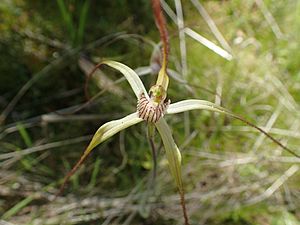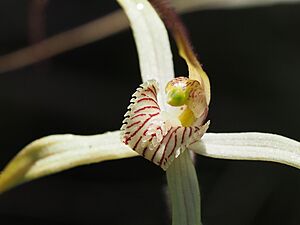Salt lake spider orchid facts for kids
Quick facts for kids Salt lake spider orchid |
|
|---|---|
 |
|
| Caladenia exilis subsp. exilis near Gunyidi | |
| Scientific classification |
|
| Kingdom: | Plantae |
| Clade: | Tracheophytes |
| Clade: | Angiosperms |
| Clade: | Monocots |
| Order: | Asparagales |
| Family: | Orchidaceae |
| Subfamily: | Orchidoideae |
| Tribe: | Diurideae |
| Genus: | Caladenia |
| Species: |
C. exilis
|
| Subspecies: |
C. e. subsp. exilis
|
| Trinomial name | |
| Caladenia exilis subsp. exilis |
|
| Synonyms | |
|
Calonemorchis exilis (Hopper & A.P.Br.) D.L.Jones & M.A.Clem. |
|
The salt lake spider orchid (scientific name: Caladenia exilis subsp. exilis) is a beautiful plant. It belongs to the orchid family. You can only find this special orchid in the south-west part of Western Australia. It's quite common there. This orchid has one upright, fuzzy leaf. It also grows up to three flowers. These flowers are usually white or greenish-cream. They have a small white part called a labellum with red stripes.
Contents
What Does the Salt Lake Spider Orchid Look Like?
The salt lake spider orchid is a ground-dwelling plant. It is a perennial herb, meaning it lives for more than two years. It loses its leaves each year, which is called being deciduous. This orchid grows from an underground tuber, which is like a small storage root. It often grows in groups or "tufts."
Leaves and Stems
Each orchid plant has one upright leaf. This leaf is usually fuzzy. It can be about 40 to 100 millimeters (1.6 to 3.9 inches) long. The leaf is also about 4 to 7 millimeters (0.16 to 0.28 inches) wide. The flowers grow on a tall stem, called a spike. This spike can be about 150 to 250 millimeters (5.9 to 9.8 inches) tall.
Flowers and Petals
The salt lake spider orchid can have up to three flowers on each spike. These flowers are usually white or a greenish-cream color. They are quite large, about 100 to 150 millimeters (3.9 to 5.9 inches) long. They are also about 40 to 60 millimeters (1.6 to 2.4 inches) wide.
- The dorsal sepal is the top part of the flower. It stands straight up. It's about 50 to 90 millimeters (2.0 to 3.5 inches) long. It's very thin, about 2 millimeters (0.079 inches) wide. It gets thinner at the end, like a dark thread.
- The lateral sepals are the two side parts of the flower. They usually hang downwards. They are also long and thin, like dark threads at their tips. They are about 50 to 90 millimeters (2.0 to 3.5 inches) long. They are about 3 millimeters (0.12 inches) wide at the bottom.
- The petals are similar to the lateral sepals. They also hang down. They are about 50 to 70 millimeters (2.0 to 2.8 inches) long. They are about 2 millimeters (0.079 inches) wide at the bottom.
The Labellum
The labellum is a special lip-like part of the orchid flower. For the salt lake spider orchid, it is about 8 to 12 millimeters (0.31 to 0.47 inches) long. It is also about 5 to 7 millimeters (0.20 to 0.28 inches) wide. It is white or cream-colored. It has red lines and spots on it. The edges of the labellum have small, forward-pointing teeth. There are also two rows of red to cream-colored bumps, called calli, along its center.
When Does it Bloom?
This orchid usually flowers between July and September.
How the Salt Lake Spider Orchid Got Its Name
The scientific name Caladenia exilis subsp. exilis was officially given in 2001. It was named by two scientists, Stephen Hopper and Andrew Brown. They published their description in a science journal called Nuytsia. The word exilis comes from Latin. It means "thin" or "slender." This name was chosen because the orchid has very thin petals, sepals, and labellum.
Where Does the Salt Lake Spider Orchid Live?
The salt lake spider orchid is quite common in Western Australia. You can find it between the towns of Woodanilling and Mullewa. It grows in areas known as the Avon Wheatbelt, Jarrah Forest, and Mallee. These orchids love to grow near salt lakes. Sometimes, you can find hundreds or even thousands of them growing together in one place!
Is the Salt Lake Spider Orchid Protected?
The Western Australian Government's Department of Parks and Wildlife has looked at the salt lake spider orchid. They have classified it as "not threatened." This means it is not currently in danger of disappearing.


